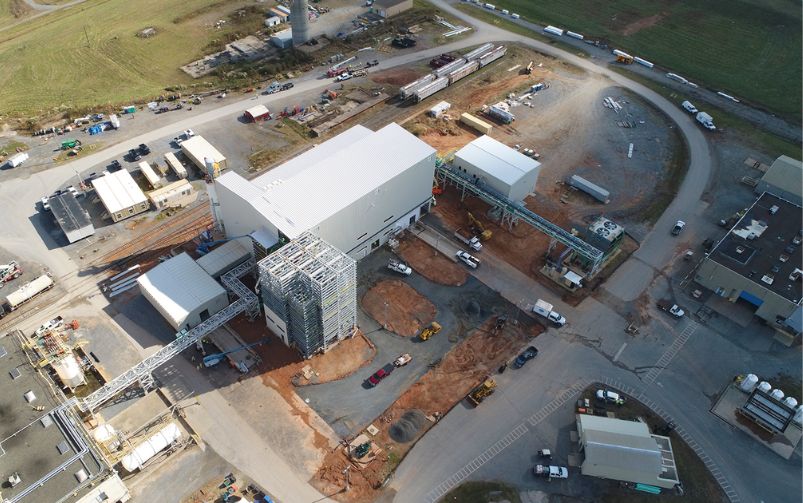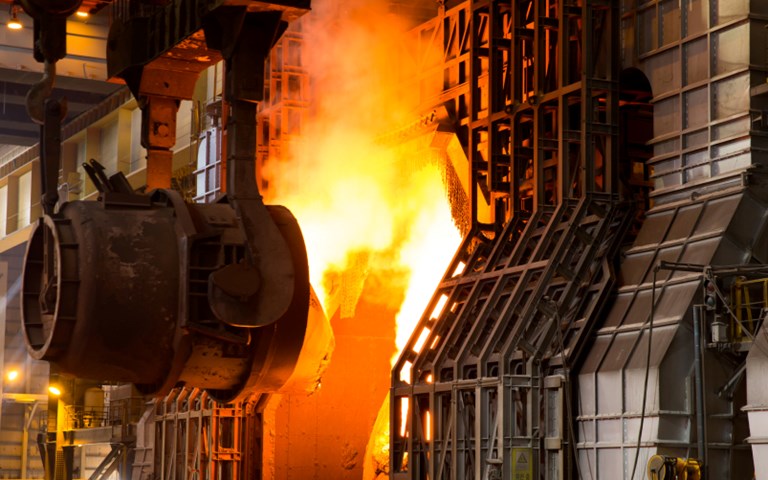A charging ladle moves hot metal into a basic oxygen furnace to be made into steel at a Pohang Steelworks (POSCO) facility in South Korea. Courtesy of World Steel Association.
New guidance from the International Council on Mining and Metals (ICMM) is aiming to improve the quality and transparency of Scope 3 greenhouse gas (GHG) emissions reporting for the industry.
The guidance, released in early September, was developed over 18 months with a working group comprised of representatives from its 25 member companies, including Barrick Gold, BHP, Freeport-McMoRan, Newmont, Rio Tinto and Teck Resources. Reporting standards creators, investors and financial institutions also provided input.
Scope 3 emissions are created in the supply chain and fall outside of a company’s direct control. While they represent the biggest portion of a company’s emissions profile—the ICMM estimates that, depending on the commodity type and other factors, Scope 3 can account for between 75 per cent and 95 per cent of a company’s carbon footprint—accounting for and reporting them has lagged behind Scope 1 and 2 emissions, and companies have taken widely varying approaches to disclosure.
In 2021, when the ICMM committed its member companies to reaching net-zero Scope 1 and 2 emissions by 2050 or sooner, the council only required members to begin reporting on Scope 3—and setting reduction targets for such emissions—by the end of 2023.
The ICMM based the guidance on Scope 3 standards from the GHG Protocol—the most widely used corporate emissions reporting guidelines in the world, which set out 15 categories of Scope 3 emissions—and tailored them to the mining industry. The ICMM document is meant to address some of the most common reporting challenges, including data quality and availability and unclear boundaries around what should be considered within scope.
Christian Spano, the ICMM’s director of innovation, told CIM Magazine that the new guidance will standardize reporting practices among its member companies and the broader mining industry, while giving companies the ability to account for the specific realities of their business.
“It was a mess before, we were all dancing to different music,” Spano said. “But now we can dance in our own style to the same song.”
Spano stressed the value of clear Scope 3 reporting from a “strategic” perspective, noting that regulators, financial institutions and investors, and other stakeholders across the supply chain, want to understand a company’s footprint and its approach to mitigating it.
During the development of the guidance, the ICMM reviewed existing Scope 3 methodologies and put out a questionnaire to its members to learn more about their approaches to reporting such emissions and general understanding of the 15 categories. From there, it consulted further with its membership as well as external experts.
“Scope 3 is super complex, so we wanted to understand the challenges [mining companies] are facing and help our members and the mining industry as a whole [with] something that is useful, not something that’s flashy and just talks about best practices,” Spano said.
Spano added that member companies were at varying levels of maturity around Scope 3 reporting, so the guidance aimed to integrate the improvements made by the most advanced companies while giving companies in earlier stages of accounting “a pathway to reach that level of maturity.”
An incentive to cooperate
While most mining companies reporting their Scope 3 emissions have, to date, relied on the GHG Protocol’s standards, a 2020 paper in Environmental Research Letters, which reviewed 2018 Scope 3 emissions disclosures for 14 major mining companies, found none reported all 15 categories. While the study’s authors said that the inconsistency reflected a variety of business models, it also indicated a lack of clarity around the boundaries of Scope 3 emissions and what is considered material for companies to report.
The guidance calls on mining companies to consider all 15 categories initially material, and provides a “heat map” of the categories that are likely to be the most material depending on the commodity type. Precious metals, for example, are likely to have purchased goods and services and fuel- and energy-related Scope 3 emissions to report, while bulk and base metals have emissions hot spots in the processing and use of sold products.
While companies may ultimately determine one or more category isn’t material to their business, the guidance said they must justify, document and declare each of those categories for transparency.
The guidance also calls for setting minimum boundaries for all Scope 3 categories. Chris Adachi, director of climate change at Teck Resources, told CIM Magazine that drawing the boundaries around what should be considered in scope has been “a healthy discussion within the industry,” but the consensus has started to settle on one step removed up and down the supply chain for material emissions sources.
Data availability and quality has been a key issue in tracking and reporting Scope 3 emissions, which can be due to suppliers or other stakeholders in the supply chain not yet collecting it or their data being relatively rudimentary; operating in jurisdictions where data-sharing may be illegal; and companies being reluctant to share information for competitive reasons.
Teck has been reporting on its Scope 3 emissions since 2012, and while it initially focused its efforts on accounting for the use of its metallurgical coal in steelmaking, Adachi said it turned its attention in the past five years to working with a third party to improve the accounting for the rest of the 15 categories. “There are levels and grades of quality you can get to, and some are out of your control,” he said, noting that companies often have to make judgments and balance between “what’s available and what’s accurate.”
The document sets out recommended data sources for each category and, if those are not available, minimum requirements. Site-specific supplier and customer data are considered the gold standard for the processing and use of sold products, consumables and upstream transport, while industry averages are often considered the minimum. Some categories can be calculated with spend-based data, and transportation emissions calculated based on distance. The guidance also provides links to good-quality industry average data and encourages companies to engage with suppliers and customers.
Qian Zhang, assistant professor at Queens University’s mining department and head of the Green Mining Value Chain lab, told CIM Magazine that he was “very excited” to see the ICMM’s new guidance, and noted that its emphasis on working with suppliers and buyers reflects the initial intention of standards creators.
“From the very beginning…the intention behind the developers of guidelines was to encourage parties across the value chain to work together to reduce total carbon emissions,” he said. Zhang pointed out that without major companies needing to track Scope 3 emissions, data quality and access issues could perpetuate because there may otherwise be little reason for suppliers or buyers to track and disclose their own footprint. “This is an incentive…to encourage collaboration to reduce the overall carbon footprint. It’s not just to approach it as an unmanageable task beyond [companies'] control.”




